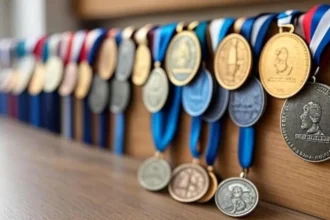Introduction to celebrity/athlete with trigger finger hand and wrist injury
In the world of sports and entertainment, physical prowess is key. celebrity/athlete with trigger finger hand and wrist injury But sometimes, even the most talented athletes and celebrities face unexpected challenges. One such challenge is trigger finger, a painful hand and wrist injury that can significantly impact performance. Imagine being a top-tier athlete or beloved star struggling with the simple act of gripping a ball or holding a microphone! This condition not only affects their craft but also raises questions about treatment options and recovery processes. Join us as we dive into the lives of some famous figures who have battled this frustrating ailment while exploring what trigger finger really means for those in the limelight.
Understanding Trigger Finger Hand and Wrist Injury
Trigger finger, also known as stenosing tenosynovitis, refers to a condition that affects the tendons in your fingers. It occurs when inflammation narrows the space within the sheath surrounding the tendon. This can lead to pain and difficulty moving your finger.
In this state, you might experience a sensation similar to clicking or locking when trying to extend or flex your digit. The affected finger may become stiff or even lock in a bent position.
This injury is particularly concerning for those who rely on their hands for performance—whether it’s athletes gripping equipment or musicians playing instruments. Understanding trigger finger is essential since early intervention can prevent further complications and allow individuals, including celebrities and athletes, to maintain peak performance without disruption.
Common Causes and Symptoms
Trigger finger, also known as stenosing tenosynovitis, affects the tendons in your fingers. Understanding its causes can shed light on why some athletes and celebrities experience this condition.
Repetitive gripping or grasping motions are primary culprits. Athletes who frequently engage in these actions—think of tennis players or baseball pitchers—are at higher risk. Additionally, those with underlying health issues like diabetes or rheumatoid arthritis may find themselves more susceptible to trigger finger.
Symptoms often start subtly. You might notice a catching sensation when you try to straighten your finger. Pain is common too, especially near the base of the affected digit. Swelling may appear, making it difficult to perform daily tasks effectively.
Recognizing these signs early can lead to better management and treatment options for anyone affected by this injury.
Famous Cases of Trigger Finger in Celebrities/Athletes
Trigger finger hand and wrist injuries have affected various celebrities and athletes, drawing attention to this often-overlooked condition. One notable case is that of tennis legend Venus Williams. Her struggle with trigger finger not only impacted her performance but also highlighted the physical toll of elite sports.
Another famous athlete, NFL quarterback Tom Brady, has faced similar challenges. Despite his rigorous training regimen, he experienced discomfort due to a trigger finger issue. This situation resonated with fans who admired his resilience in overcoming obstacles.
Musicians are also not immune. The iconic guitarist Eric Clapton dealt with this ailment during his career, demonstrating how even the most talented performers can be hampered by such injuries.
These cases serve as reminders that trigger finger can affect anyone—regardless of their level of fame or athletic prowess.
Treatment Options for Trigger Finger
Treatment for trigger finger varies depending on the severity of the condition. For mild cases, rest and activity modification are often recommended. Avoiding repetitive motions can significantly ease symptoms.
Physical therapy plays a crucial role in recovery. Specific exercises help improve flexibility and strength in the hand. Stretching techniques may also alleviate tension around affected tendons.
In more persistent cases, corticosteroid injections provide relief by reducing inflammation within the tendon sheath. This method is particularly effective when paired with steroid options for faster results.
For severe or non-responsive instances, surgical intervention might be necessary to release the constricted tendon sheath. Patients typically experience significant improvements post-surgery and can return to their activities with renewed functionality.
Always consult a healthcare professional before deciding on a treatment plan tailored to individual needs.
Prevention Tips for Athletes and Performers
Preventing trigger finger injuries is crucial for athletes and performers. One effective strategy is to incorporate regular stretching into your routine. Simple hand stretches can enhance flexibility and reduce strain on the fingers.
Warming up properly before any activity also plays a vital role. A few minutes of gentle movements can prepare your hands for intense performance or training sessions, minimizing the risk of injury.
Using ergonomic equipment is another smart move. Whether it’s specially designed grips or tools that suit your needs, having the right gear can alleviate unnecessary pressure on your fingers and wrists.
Listening to your body cannot be overstated. If you feel discomfort in your hands or wrists, take breaks as needed. Ignoring signals from your body often leads to more significant issues down the line.
The Importance of Proper Rehabilitation
Proper rehabilitation is crucial for athletes dealing with trigger finger hand and wrist injuries. It helps restore function, strength, and flexibility in the affected area.
Many underestimate the healing process, thinking rest alone will suffice. Without a structured rehab program, one risks long-term complications or re-injury.
A personalized rehabilitation plan often includes physical therapy exercises tailored to improve range of motion. These exercises focus on strengthening muscles surrounding the injury while promoting blood flow.
Additionally, guidance from medical professionals ensures that recovery progresses safely. They can monitor pain levels and adjust treatments as needed.
Incorporating occupational therapy can also be beneficial. This approach prepares athletes to return to their sport without limitations or fears of aggravation.
Mental wellness plays an important role in recovery too. Staying positive and motivated can significantly impact how quickly one returns to peak performance.
Conclusion
For many athletes and celebrities, a trigger finger hand and wrist injury can be more than just inconvenient. It can hinder their performance and impact their careers.
Understanding the nuances of this condition is crucial for both fans and fellow performers. Awareness leads to better support systems.
Recognizing symptoms early helps in seeking timely treatment.
The journeys of those who have faced this challenge inspire others facing similar issues. They shed light on perseverance amidst pain.
Treatment options are available, but each case requires personalized care. Rehabilitation plays a pivotal role in recovery, ensuring that one returns stronger.
Awareness about prevention strategies empowers individuals to take control of their health. Education fosters resilience within athletic communities as they navigate physical challenges together.
FAQs
Q: What is trigger finger?
A: Trigger finger, also known as steno-synovitis, occurs when the tendons in your fingers become inflamed. This inflammation can cause your fingers to lock or catch when you try to bend them.
Q: Who is a famous athlete with trigger finger?
A: Several athletes have dealt with this condition. One notable example includes former NBA star Derrick Rose, who has openly discussed his struggles with hand injuries that impacted his performance.
Q: How does trigger finger affect an athlete’s performance?
A: Athletes rely heavily on their hands and wrists for various skills. Trigger finger can lead to pain, stiffness, and decreased range of motion, making it difficult for athletes to perform at their best.
Q: What are some common treatment options for trigger finger?
A: Treatment often starts conservatively with rest and anti-inflammatory medications. If symptoms persist, corticosteroid injections or even surgery may be considered in more severe cases.
Q: Can I prevent trigger finger if I’m an athlete?
A: While not all cases are preventable due to genetics or specific sports demands, maintaining proper form during activities and taking regular breaks can help reduce the risk of developing trigger finger.
Q: How long does recovery from a trigger finger injury take?
A: Recovery time varies depending on the severity of the condition and chosen treatments. With appropriate care—such as physical therapy—athletes may see improvement within weeks but complete recovery could take several months.
Q: Is rehabilitation necessary after treatment for trigger finger?
A: Yes! Rehabilitation helps restore strength and flexibility to the affected hand while minimizing recurrence risks. Following a tailored rehab program significantly improves long-term outcomes for athletes facing this issue.

















